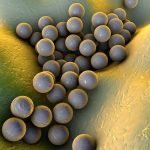Take a Bite Out of Lyme
Emily Maiella, ND
It’s bad news for you if you live in Vermont or Delaware. The most recent figures from the Centers for Disease Control and Prevention (CDC) for Lyme Disease prevalence in 2011 show that Delaware led the nation with more than 767 reported cases for every 100 000 residents. Vermont had 476 cases per 100 000 residents. But this is only scratching the surface. The CDC reported in September of this year that there is a much higher prevalence of Lyme disease than has officially been recognized. Typically, the CDC estimates 30 000 cases per year in the United States. The true incidence, according to CDC officials, is probably 10 times greater – ie, around 300 000 cases per year.1 The Northeast is by far the hot spot of the Lyme disease epidemic, though this disease has reached every state in the country. The United States is not alone; Western Europe struggles with Tick-Borne Illness (TBI) as well.
The Politics
Lyme disease, and especially the notion of “chronic Lyme disease,” is an area of contention between many doctors. This debate is driven by a number of issues, namely science, politics, and the insurance industry. It is a very heated and emotional topic for people, especially those who are struggling with their health and are suspicious that Lyme disease is the causative agent of their illness.
Over the past decade, 2 opposing camps have emerged in the battle over this tick-borne illness. One camp is represented by the Infectious Diseases Society of America (IDSA), led by a group of academic researchers. This group maintains that Lyme disease is easily treated with only 2 to 4 weeks of antibiotics. This group also claims that chronic Lyme disease is rare or non-existent following treatment.2 Unfortunately, this is the group of researchers who have written the guidelines that most physicians refer to when treating Lyme disease. But, here’s the catch…The IDSA guidelines’ authors have significant conflicts of interest that have biased their treatment and diagnostic recommendations. These conflicts include: 1) commercial interests in tick-borne disease tests and vaccines; and 2) supplemental streams of income from insurance companies that profit from a restrictive definition of Lyme disease.3
The opposing camp is represented by the International Lyme and Associated Diseases Society (ILADS), led by a group of practicing physicians. Its members argue that tick bites often go unnoticed and that a Lyme disease diagnosis is frequently missed, especially since commercial laboratory testing for Lyme disease is inaccurate.4 Consequently, the disease is often not recognized and may persist in a large number of patients, requiring prolonged therapy to eradicate persistent infection.
Life Cycle
The life cycle of a deer tick (Ixodes scapularis, aka blacklegged tick) can be difficult to grasp; however, it is important to understand so that you know what to look for in different seasons. Every season has 2 generations of ticks – a combination of adults, larvae, and nymphs.
Let’s begin in the fall or winter, when the ticks are mating. After they mate, they spend the rest of the fall or winter looking for a blood meal. During the winter, many of the adult deer ticks lay dormant, though anytime that there is no snow cover they are out and looking for a blood meal. They prefer environments like leaf piles to keep them warm. Eggs hatch mid-summer, with a peak in larvae in August. These new ticks, called larvae, have their first blood meal on a small animal, such as a mouse. If they have a successful feed, they will molt in the fall into nymphs and do nothing until May of the following year. Then from May through the rest of the summer, the nymph (which had been dormant during the last year’s fall and winter), will be active all summer long. The nymph is the most likely form to transmit the infection, due to its stealthy size and the fact that it is active when people are outdoors and active and wearing less clothing. Larvae are smaller than nymphs, and do not carry the disease until they meet their first host. Male deer ticks do not transmit disease.
Ixodes scapularis ticks, on average, carry Borrelia burgdorferi (Bb) – the most common cause of Lyme disease – anywhere from 24-29% of the time.5 In some regions of the country, that statistic can get into the 75% range. To find out the statistics in your area, visit the Tick-borne Diseases Passive Surveillance website at http://stats.tickdiseases.org/.
All types of ticks can be directly tested via polymerase chain reaction (PCR) analysis for the presence of (Bb) and other cause of TBIs. Deer ticks may also carry Babesia microti, Borrelia miyamotoi, and the rare and deadly Powassan encephalitis virus.6 Many states and private labs have access to this type of technology. PCR testing is specific for particular organisms; eg, PCR for Borrelia burgdorferi will not detect other types of bacteria as well. These laboratory tests are more than 99.9% accurate at detecting as few as 3 copies of Bb.7
Diagnosis
While Lyme disease is increasing in every state, the CDC readily admits that underreporting is a major issue for 2 reasons: 1) inaccurate testing, therefore misdiagnosis; and 2) failure by physicians and laboratories to report positive diagnoses.
According to the CDC, Lyme disease is diagnosed on the basis of physician-observed clinical manifestations and a history of probable exposure to infected ticks. For patients with recent onset (2-3 weeks) of a characteristic erythema migrans rash, laboratory tests are neither suggested nor required to confirm diagnosis. However, positive results of recommended 2-tiered serologic testing can help provide confirmation of infection in patients with musculoskeletal, neurologic, or cardiac symptoms.8 To summarize, the CDC emphasizes that you should not rely on blood testing to confirm or deny the diagnosis of Lyme disease. But why, if Lyme disease is a clinical diagnosis, based on patient history, signs and symptoms, can we not, as physicians, report the illness to the appropriate agency without running serologic tests?
There are all sorts of tests that can be employed for detecting infection, such as antibodies, PCR and culture. However, the spirochete has about a dozen ways to evade the immune system, so its detection is difficult. The western blot can be useful in some cases, especially if used 4-6 weeks following the tick bite, when test results are most likely to be accurate. There are, however, nuances and tricks to interpreting the western blot test, which I suggest you learn. All bands are not created equal, and the conventional western blots have excluded the most informative and specific bands, 31 kDa (Osp A) and 34 kDa (Osp B), which appear later in the response.9
Some of the most common signs and symptoms of acute Lyme disease include: headache, myalgia, heart palpitations, stiff neck, arthralgia, and a rash. An erythema migrans rash is pathognomonic (no further testing required) for borreliosis; however, rashes (of any sort ) are only seen in 40-60% of people who are bitten and contract Borrelia spp. Of these 40-60% of patients, 10% of the rashes are the classic erythema migrans (“bull’s-eye”).10
The signs and symptoms list is actually much longer than this, and often overlaps with the symptoms that one might have with a cold or flu. This is where the beginning of chronic Lyme disease can be tragically overlooked and dismissed. I have found that in every season, the disease looks a bit different, which I hypothesize is due to different strains of Borellia. This year, the clinical presentation was quite neurological, with eye pain and headaches.
How long it takes a tick to transmit disease after it has attached is debatable. The CDC states that it must be attached for 36-48 hours before it can transmit Lyme disease.11 Other reputable sources, such as the International Lyme and Associated Disease Society, believe that it can transmit disease in less than 24 hours.12 I have personally seen ticks transmit their disease within 4 hours, without a doubt. I think that what truly dictates whether a person may fall ill with the disease is determined by their “total load.” A vital immune response to Borrelia might be comprised of a bull’s-eye rash and a fever. There would be no missing the diagnosis there. But adults, especially, do not tend toward these immune reactions. Our immune systems are generally a bit compromised, so we mount weaker reactions and pay little attention to them in our busy lives. It has been my observation that children will mount stronger responses to an infection with Borrelia and that their diagnoses are less likely missed.

Treatment
The key to successfully treating Lyme disease is immediate treatment. I do advocate for the use of antibiotics for a recent infection. Antibiotics are absolutely the most effective treatment for early Lyme disease. For late-stage, chronic Lyme disease, many patients require a prolonged course (months to years) and high doses of antibiotics, sometimes intravenously. Though many people with chronic Lyme feel better when on antibiotics, some may relapse as soon as they discontinue the medication. For this reason, I do not feel that the sole use of antibiotics is a sustainable treatment, as bacteria may become drug-resistant, not to mention the harsh and sometimes intolerable side effects of antibiotics.
There are many effective natural medicines emerging in the research as potential anti-spirochetal agents. For example, the invasive species of Polygonum cuspidatum, or Japanese knotweed, which has taken over parts of Western MA where I live, can be useful in Lyme disease. What a wonderful example of how nature provides humans with exactly what we need! Other effective choices are Uncaria tomentosa, Smilax, Dipsacus (teasel), Andrographis, Stephania, Guaiacum, and Stillingia.
What is important to remember, when designing a treatment protocol for a patient with chronic Lyme, is that fighting the infection, itself, should not be the only priority. Chronic Lyme and other TBIs can affect the immune system in ways that differ from the standard infection-mediated pattern. The immune system of patients that have the HLA-DR2 or HLA-DR4 alleles (inherited from mom or dad) responds in such a way that creates a hyper-inflammatory or even autoimmune type of inflammatory cascade. These patients will have a harder time eradicating the infection and may need a longer course of antibiotics. In addition, it is more difficult to assess when to stop treatment in these patients. HLA-DR2 and DR4 patients are more predisposed to having a post-Lyme syndrome. These patients tend to struggle with their health for a while longer until their immune system regains control and the inflammation is halted. This is where your immune-modulating and anti-inflammatory herbs can be useful.
The Lyme disease epidemic may sound dismal, and many of us have been infected, but it may also serve as a catalyst for our community to become more aware of the human impact on the earth, eg, climate change, which, for one, has reduced the number of deep freezes each year. Remember, as a species, we have always battled infectious agents. Some bacterial species, such as those that caused cholera or the plague, have wiped out huge numbers of people. Other bacteria, viruses, and fungi remain more benign and live symbiotically with humans. It’s hard to say what impact this epidemic will have on us, but I have faith that with a higher awareness and a strong and vital immune system, we will continue to thrive as a species (even with the ticks.) When I walk in the woods nowadays, I try to emit a loving energy into nature, asking for protection for myself and for the planet. Walking in fear certainly does not help the situation.
 Emily Maiella, ND is a licensed naturopathic physician practicing in Brattleboro, VT and Montague, MA. Her practice currently focuses on the treatment of chronic Lyme disease, tick-borne illnesses, and the comorbid syndromes that are associated with these infections. She has been attending ILADS conferences since 2006, and lectures around New England on the topic. Over the last few years she stands proud in her profession, as she has witnessed the tremendous benefits of our naturopathic tools in the treatment of these diseases.
Emily Maiella, ND is a licensed naturopathic physician practicing in Brattleboro, VT and Montague, MA. Her practice currently focuses on the treatment of chronic Lyme disease, tick-borne illnesses, and the comorbid syndromes that are associated with these infections. She has been attending ILADS conferences since 2006, and lectures around New England on the topic. Over the last few years she stands proud in her profession, as she has witnessed the tremendous benefits of our naturopathic tools in the treatment of these diseases.
References
- Centers for Disease Control and Prevention. Lyme Disease. CDC Web site. http://www.cdc.gov/lyme/stats/. Updated September 16, 2013. Accessed October 15, 2013.
- Wormser GP, Dattwyler RJ, Shapiro ED, et al. The clinical assessment, treatment, and prevention of lyme disease, human granulocytic anaplasmosis, and babesiosis: clinical practice guidelines by the Infectious Diseases Society of America. Clin Infect Dis. 2006;43(9):1089-1134.
- Johnson L, Stricker RB. Attorney General forces Infectious Diseases Society of America to redo Lyme guidelines due to flawed development process. J Med Ethics. 2009;35(5):283-288.
- International Lyme and Associated Diseases Society. Basic Information About Lyme Disease. ILADS Web site. http://www.ilads.org/lyme_disease/about_lyme.html. Accessed October 15, 2013.
- Tick-borne Diseases Passive Surveillance. Laboratory of Medical Zoology Web site. http://stats.tickdiseases.org/. Accessed October 15, 2013.
- Lyme Disease Frequently Asked Questions. Public Health Agency of Canada Web site. http://www.phac-aspc.gc.ca/id-mi/lyme-fs-eng.php#s13. Updated May 15, 2013. Accessed October 15, 2013.
- Tick-Borne Disease Diagnostics. University of Massachusetts Amherst. http://ag.umass.edu/services/tick-borne-disease-diagnostics. Accessed October 15, 2013.
- Centers for Disease Control and Prevention. Two-step Laboratory Testing Process. CDC Web site. http://www.cdc.gov/lyme/diagnosistesting/LabTest/TwoStep/. Updated November 15, 2011. Accessed October 15, 2013.
- An Understanding of Laboratory Testing for Lyme Disease. Journal of Spirochetal and Tick-Borne 1998;5(Spring/Summer). Igenex Web site. http://www.igenex.com/labtest.htm. Accessed October 15, 2013.
- Bastyr Center for Natural Health. Lyme Disease: A Silent Epidemic. Bastyr Center Web site. http://www.bastyrcenter.org/content/view/1034/. Accessed Ocober 15, 2013.
- Centers for Disease Control and Prevention. Lyme disease transmission. CDC Web site. http://www.cdc.gov/lyme/transmission/index.html. Accessed October 15, 2013.
- Stricker R. Rapid Transmission of Lyme Disease Following a Tickbite. [Lecture] ILADS Web site. http://www.ilads.org/media/boston/slides/stricker/stricker.html. Accessed October 15, 2013.
- Maloney EL. The management of Ixodes scapularis bites in the upper Midwest. WMJ. 2011;110(2):78-81.










